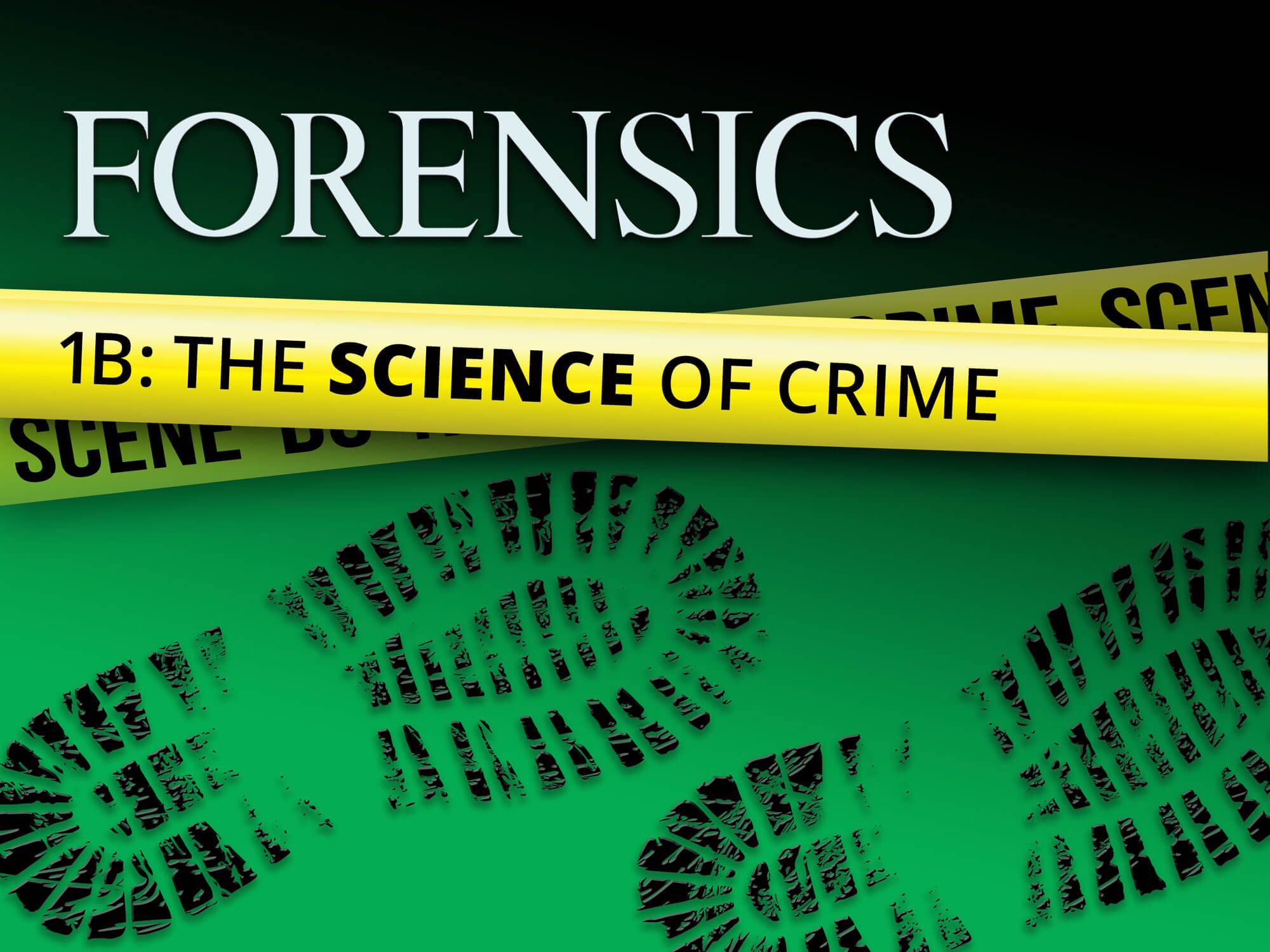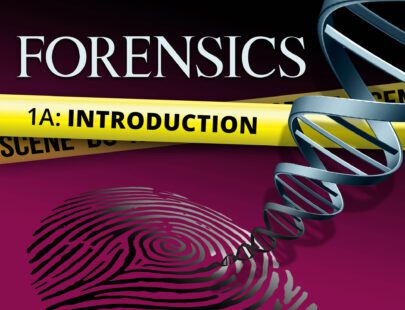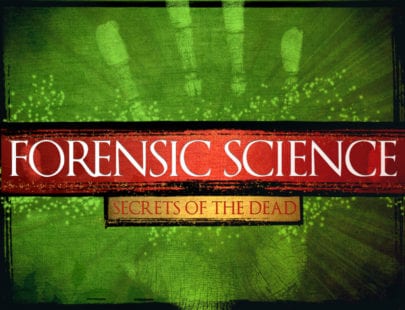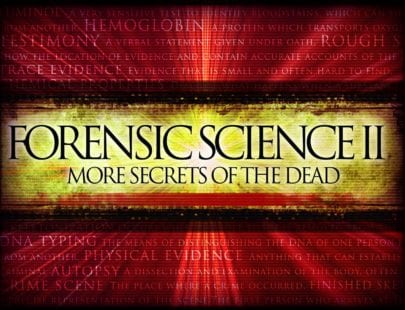
Forensics 1b: The Science of Crime
You’ve investigated the surface and have started building a case, but now it’s time to examine the field of forensics further. In this course, you will delve into the details, studying DNA analysis, forensic anthropology, tool marks, arson, impressions, toxicology, questioned documents, and digital forensics. You will also explore the different specialties within a forensics team. You’ll learn more about what each field entails, what that specialist does at the scene and in the lab, and what conclusions can be made based on their analysis. Let’s continue strengthening your case and interests for this fascinating field.
Units at a Glance
Unit 1: Analyzing DNA
Watch any detective show on television and you will see someone sending a DNA sample to the lab for testing. But what exactly is DNA? How do forensic scientists actually retrieve it off a surface like a glass at the crime scene? And then how does that sample lead to clear results that can be presented in front of a jury? Identifying DNA is not a simple process, and forensic scientists need to understand exactly how DNA is designed and functions so that they can work correctly with DNA and read the results of analytical processes. With all the science involved and helpful technology, forensic scientists need to make sure that they know the basics of how DNA is structured, collected, analyzed, and stored.
What will you learn in this unit?
- Describe the structure and function of DNA
- Explain the analytical procedures for forensic DNA typing
- Locate resources to analyze DNA results, including a national database
- Collect and preserve DNA samples
Unit 2: Developing a Narrative of Death
In a murder case, investigators will need to know how, when, and where a person died. Fortunately, there is a lot that the body itself can tell forensic scientists to make this information clear. Understanding the processes that a body goes through after death is just one of the ways that forensic scientists use to figure out when a person died. But this is just part of the basic anatomy that forensic scientists need to know to properly analyze and document the scene where the body is found.
What will you learn in this unit?
- Differentiate between cause of death, mechanism of death, and manner of death
- Articulate phases of mortis and decomposition
- Explain the role of entomology in determining time of death
- Recognize basic bone structures and the makeup of bones
- Explain identifying features of human remains
Unit 3: Firearms and Tool Marks
It is very hard to fire a gun without leaving a trace, and this means that firearms are an important source of forensic evidence. From the bullets that they leave behind to the residue that appears on the scene, firearms give investigators a lot to work with. Forensic scientists need a basic understanding of how guns work and the different types of firearms so that they know what to look for at the scene and the places to find the distinctive markings that will connect a bullet to the gun that fired it.
What will you learn in this unit?
- Evaluate the different projectiles used in firearms
- Differentiate among types of firearms
- Describe identifying marks on bullets and casings
- Explain proper techniques for collecting and analyzing ballistic evidence
- Explore how ballistic evidence and tool marks are analyzed
Unit 4: Explosives and Arson
How do you solve a crime when all of your evidence has caught on fire? Understanding the dynamics of fire and the kinds of evidence that explosives leave is key for arson investigators, a specialized type of forensic scientist. Discover the types of trace evidence left at these scenes, the technology involved in analyzing this evidence, and how this evidence can later be used in cases.
What will you learn in this unit?
- Articulate the properties and elements of fire
- Differentiate among types of explosives
- Identify elements arson investigators look for at a crime scene
- Describe standard practices in arson evidence collection
- Discuss the types of forensic testing used for evidence from arson and explosion crime
Unit 5: Impressions and Patterns
If something valuable is locked up, a criminal is going to have to pry something open to get at it. When they do, they leave telling evidence behind for analysis. Toolmarks are just one type of impression evidence. The tire tracks left behind when the criminal speeds away or a footprint in the mud are also important clues that help investigators build a case. Collecting and analyzing this kind of evidence is all in a day’s work for forensic scientists.
What will you learn in this unit?
- Identify different types of impression evidence
- Demonstrate appropriate techniques for identifying and collecting impression evidence
- Differentiate among casting techniques for different types of impressions
- Discuss various databases that aid law enforcement in impression evidence analysis
- Evaluate the significance of toolmark evidence and common tools used in crimes
Unit 6: Is It Poison?
Is it murder or an accident? The signs of poisoning can be subtle, so forensic scientists need to be alert to the possibility. Even if a crime is not as extreme as murder, often drugs will be involved. In other cases, toxic elements in the environment can poison people. This means that forensic scientists need to know what to look for and how to prove which substances are present so that they properly assess the crime scene.
What will you learn in this unit?
- Identify the types of environmental poisons
- Differentiate among the effects of common illegal drugs
- Describe the types of poison exposure and the way poisons travel through the body
- Explain quantitative and qualitative testing options for toxic substances
Unit 7: Document Analysis
A common reference in professional spaces is to “follow the paper trail” when talking about trying to sort out who did or said what while on the job. But what happens when the paper is the trail? That is where document analysis comes in. Thanks to training and technology, forensic scientists can scrutinize paper trails as they do footprints and follow that paper trail to its source.
What will you learn in this unit?
- Discuss the most commonly forged documents and the types of alterations made to them
- Summarize the role of forensic document examiners when they are given a questioned document
- Describe unique features of handwriting and how it is analyzed
- Explain the types of tests that can be done to analyze an ink sample
- Identify anti-counterfeit measures in US currency
Unit 8: Digital Forensics
If you are a fan of working with technology, forensic computing might be the career for you! Computers, tablets, cell phones, and other devices all leave digital information trails that are particularly useful when investigating crimes. So much of our daily lives is documented on technology that skilled experts can retrieve a lot of information about where we have been or what we have been looking up online. In addition, new equipment and techniques are constantly expanding the field and they will require skilled professionals to use them, so there are a lot of forensic careers for those with technical skills.
What will you learn in this unit?
- Describe the components of a computer and explain which components are of greatest interest to a digital forensic specialist
- Contrast the types of data stored in a computer
- Identify the types of data users create when browsing the internet
- Discuss what phone data offers the most detail about its user
- Summarize how biometric data is used in law enforcement
- Reflect on which fields of forensic science interest you and identify what educational experience and soft skills you would need to join those fields
Required Materials
Physical
- Audio recording device
- Bowl
- Calculator
- Cheesecloth
- Cocoa powder (3 Tbsp)
- Cutting board
- Digital camera
- Disposable cups (10)
- Drinking glasses (2)
- Envelopes (4)
- Eye dropper
- Fire source
- Funnel
- Goggles
- Heat source
- Household solutions (9)
- Igniting device
- Isopropyl alcohol
- Kitchen knife
- Large resealable bag
- Large storage container
- Lined paper (6)
- Liquid dish soap
- Long stick (2)
- Marshmallows (1 bag)
- Measuring cups
- Mixing bowls (2)
- Nitrile gloves
- Nonstick cooking spray
- Paper (3)
- Plate
- Pot
- Red cabbage (1)
- Ruler
- Salt
- Sanitizer
- Shoes (3)
- Soft brush
- Sponge
- Strainer
- Strawberries (3–5)
- Tablespoon
- Teaspoon
- Tweezers
- Water
- Wet cleaning cloth
- Writing supplies
Software
- Google Docs (requires login)
- Graphic design software
- Word processing software
Other
- Helpers (4)
Optional
- Art supplies
- Chocolate bars (2)
- Fire extinguisher
- Graham crackers (1 pack)
- Magnifying glass
- Presentation software
- Printer
- Spreadsheet software
- Video recording device





